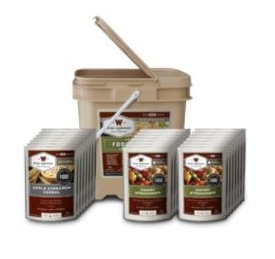Do you have the “recommended” three days of food and water set aside for an emergency or disaster? Is your plan to go to a government shelter after a disaster, even if you have your own shelter or your home is still habitable? If so, you should think again.
You can find recommendations on emergency food storage from the Red Cross, your local government, disaster preparedness gurus, and many others, and the recommendation looks like this: “Set aside three days of food and water in case of a disaster.”
Of course, it’s not difficult to put this much food aside, and it’s definitely not a bad thing to do. Many people already have more than three days of food in their cupboards and pantries (although the usual recommendation is to have this three days of emergency food set aside in a separate location, ideally in a box that’s easy to move, so that you can take it with you if you need to evacuate). Please note one more issue that is occasionally addressed: You can take that box of food and (since it’s portable) simply give it to someone else who needs it (e.g., an unprepared neighbor), assuming you have enough yourself.
But is three days of food and water for an emergency a realistic amount for you and your family? I can’t answer for you and your family, but I’ll give you the answer for me and mine: “No!” Why do I think three days of reserve food and water insufficient? When I’ve heard this recommendation in the past, the logic behind it (which I only recently heard called out explicitly) is that three days of food will give you enough buffer to get by until you are able to get to a government shelter. What is your plan in a serious emergency or natural disaster? Do you not have a plan? Uh oh! Let’s back-track for just a moment. While this article isn’t about creating a full disaster plan, let’s look quickly at the angle. If nothing else, ask yourself these questions:
- If the power goes out for over a week (since power outage is the result of most disasters, e.g. earthquake, hurricane, nuclear reactor meltdown, regional flooding, tornado, etc.), what will you [and family, friends, as applicable] do? Is your goal to go stay at home (assuming it’s habitable) or is your plan to go to a government shelter? By the way, if you don’t have a plan for more than a couple days of food and water, your default plan is to have the government take care of you!
- If your local gov’t is your plan, let’s ask one more question: Are you confident that within three days, your local government will have a clean, safe, stocked shelter ready for you and your family (but not pets – not allowed) to move into? Once you’ve given at least a moment’s thought, let’s focus more on self-sufficiency and ask the next question…
- How long do you want to be able to comfortably eat and drink (more on water storage in a separate article) if you can’t leave your home?

Three days is a minimum, and of course you should have that ready to use or give away. But let’s look at some better, convenient options. Quickly, let’s review the types of food you can store. Of course, fresh food isn’t an option for a power-out situation, unless it’s coming from a local farm or garden.
- Bagged/boxed food: it can often last up to a year or more, and needs to be regularly rotated into your everyday food stores.
- Canned food: it can also last a year or more, and needs to be rotated in order to prevent needing to throw away expired food each year.
- Dehydrated food: Dehydrated fruits & some other products can last up to a few years.
- Freeze-dried food: This is my favorite option, though more expensive than the next option. You can get canned or bagged freeze-dried food that will last 20-30 years, and if you prefer, you can get meals that only need to add water, vs. raw ingredients (next option), which will require more preparation.
- Raw foods: Wheat, rice, beans, corn, and other grains are easy and relatively inexpensive to store in cans or larger containers, and they can last 20-30 years, and in some cases longer. Preparation is more labor-intensive (e.g. grinding wheat), resource-intensive (e.g. baking bread), and time-consuming (e.g, soaking beans overnight vs. simply adding water to freeze-dried food).
The easy way to set aside one, two, or three weeks (which should be the minimum, in my opinion) worth of food is to regularly set aside a small amount of canned and boxed food (even if it’s just one can or box), every time you come back from the grocery store. If you don’t have a big budget to set aside food right now, this approach allows you to gradually grow your emergency food supply, maybe only an extra day of reserve at a time (or even less), until you reach your goal.

Another way, if you have a little more cash set aside, is to buy free-dried. In my opinion, this is the easiest option for long-term, “buy-and-forget” emergency food storage. You can buy a one-week, one-month, or even one-year (if you have the $, space, and that much concern) supply, store it and be done with it for the next 20-25 years. That is convenient! Freeze-dried food is my favorite option for those reasons:
- Long term storage: Canned, freeze-dried food is usually good for 25 years, sometimes longer.
- Easy to prepare: All you need to do is add hot water (or even cold water if you want to wait longer for it to reconstitute), wait a couple minutes and eat a prepared entree (e.g., spaghetti and meat sauce, beef Stroganoff, chicken teriyaki).
- Easy to organize: Take your bucket or box of #10 cans and stick them on a dry shelf. Mark the date on them and come back every couple years to make sure they haven’t been damaged. No rotating necessary. If you store canned/boxed food, you’ll need to rotate (still not a big deal). And if you store canned, raw ingredients, you’ll need to make sure you’re storing enough of the components to make a meal later. E.g., a ton of wheat will go a long way, but you’ll be sick (figuratively and possibly literally, depending on your innards) of eating hot wheat berries for breakfast and bread for lunch after about one day. You’ll need a wider variety of ingredients.
A downside, at least at first glance, is price. However, give it a little thought anyway. Storing a significant quantity of freeze-dried will probably look quite a bit more expensive at first glance, but when you compare to a can or bucket of wheat, rice, beans, spices, etc. and factor in the cooking time and facilities necessary to make them edible, the additional water and other ingredients you’ll need to consider, weight (if you ever need to move your food), etc., the option that seems less expensive now may feel much more expensive later when you need to use those supplies.
Note: Canned freeze-dried food will last far longer than mylar pouches by themselves (with the exception of the Wise foods mylar bags that are sealed again inside a plastic bucket). The Mountain House, Alpine Air, or other brand mylar-bag-packed food you can buy at your local sporting goods store usually lasts five to seven years, whereas the same meal in a #10 can (the usual size, typically Mountain House brand, but there are others) will usually last 20-25 years.
Of course, three days of food is a nice start, but regardless of how you want to store emergency food, consider at least three weeks. It’s easy!
